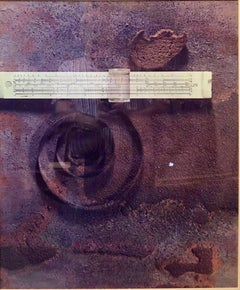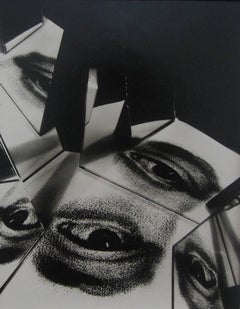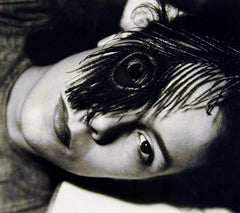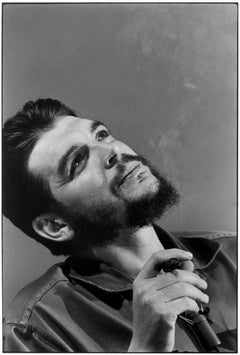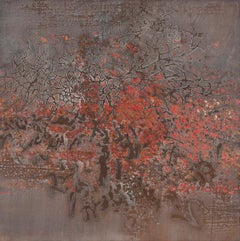Gyorgy Kepes Art
to
4
3
1
3
1
Overall Height
to
Overall Width
to
1
1
1
1
1
1
1
4
1
1
1
4
6,997
3,373
2,513
1,212
3
1
Artist: Gyorgy Kepes
Vintage Large Format Avant Garde Polaroid 20X24 Photograph
By György Kepes
Located in Surfside, FL
Sorry for the reflection on the plexi. In the early 1980s, the Polaroid Foundation invited Hungarian-born painter and photographer György Kepes (1906-2001) to use the 20x24 Polaroid camera. The resulting carefully staged compositions summarize many of his artistic concerns, employing such objects as prisms, flowers, and graphic papers to manipulate the effects of light and form.
György Kepes 1906-2001 was a Hungarian-born painter, photographer, designer, educator, and art theorist. After emigrating to the U.S. in 1937, he taught design at the New Bauhaus (later the School of Design, then Institute of Design, then Illinois Institute of Design or IIT) in Chicago. In 1967 He founded the Center for Advanced Visual Studies at the Massachusetts Institute of Technology (MIT) where he taught until his retirement in 1974. Kepes was born in Selyp, Hungary. His younger brother was Imre Kepes, ambassador in Argentina, father of András Kepes journalist, documentary filmmaker and author. At age 18, he enrolled at the Royal Academy of Fine Arts in Budapest, where he studied for four years with Istvan Csok, a Hungarian impressionist painter. In the same period, he was also influenced by the socialist avant-garde poet and painter Lajos Kassak.
Kepes gave up painting temporarily and turned instead to filmmaking. In 1930, he settled in Berlin, where he worked as a publication, exhibition and stage designer. Around this time, he designed the dust jacket for Gestalt psychologist Rudolf Arnheim's famous book, Film als Kunst (Film as Art), one of the first published books on film theory. In Berlin, he was also invited to join the design studio of Laszlo Moholy-Nagy, the Hungarian photographer who had taught at the Dessau Bauhaus. When, in 1936, Moholy relocated his design studio to London, Kepes joined him there as well.
Kepes was lured to Brooklyn College by Russian-born architect Serge Chermayeff, who had been appointed chair of the Art Department in 1942. There he taught graphic artists such as Saul Bass.
In 1944, he published Language of Vision, an influential book about design and design education. In part, the book was important because it predated three other influential texts on the same subject: Paul Rand, Thoughts on Design (1946), László Moholy-Nagy, Vision in Motion (1947), and Rudolf Arnheim, Art and Visual Perception (1954).
In 1947, Kepes accepted an invitation from the School of Architecture and Planning at MIT to initiate a program there in visual design, a division that later became the Center for Advanced Visual Studies (c1968). Some of the Center's early fellows included artists Otto Piene, Vassilakis Takis, Jack Burnham, Wen-Ying Tsai, Stan Vanderbeek, Maryanne Amacher, Joan Brigham, Lowry Burgess, Peter Campus, Muriel Cooper, Douglas Davis, Susan Gamble, Dieter Jung, Piotr Kowalski, Charlotte Moorman, Antoni Muntadas, Yvonne Rainer, Keiko Prince, Alan Sonfist, Aldo Tambellini, Joe Davis, Bill Seaman, Tamiko Thiel, Alejandro Sina, Don Ritter, Luc Courchesne, and Bill Parker...
Category
1980s Conceptual Gyorgy Kepes Art
Materials
Polaroid
Eyes, Chicago by György Kepes, 1940, Silver Gelatin Print, Photography
By György Kepes
Located in Dallas, TX
Untitled #42 (Eyes, Chicago), by György Kepes is a 4 1/2 x 3 5/8 inch gelatin silver print mounted on 16 1/4 x 13 1/4 inch paper. This photograph is signed and dated in pencil on mou...
Category
Mid-20th Century Modern Gyorgy Kepes Art
Materials
Silver Gelatin
Juliet with One Peacock Feather Eye, Chicago
By György Kepes
Located in Dallas, TX
Signed, dated and numbered.
Portfolio Twelve Photographs, No. 13
György Kepes was a Hungarian artist born in 1906. He studied painting at the Budapest’s Academy of Fine Arts. In 193...
Category
1930s Bauhaus Gyorgy Kepes Art
Materials
Silver Gelatin
Fluid Patterns
By György Kepes
Located in Dallas, TX
Signed, dated and numbered.
Portfolio "Twelve Photographs", No. 13
György Kepes was a Hungarian artist born in 1906. He studied painting at Budapest’s Academy of Fine Arts. In 1937,...
Category
1940s Bauhaus Gyorgy Kepes Art
Materials
Silver Gelatin
Related Items
'Dione and Tethys'
Located in London, GB
'Dione and Tethys' 2005 JPL/Cassini
A beautiful 16x16" inches / 40 x 40 cm Silver Gelatin fibre print (printed on 20x16" paper size)
of this breathtakingly exquisite Cassini image ...
Category
Early 2000s Modern Gyorgy Kepes Art
Materials
Silver Gelatin
Che Guevara, Havana, 1964 - Elliott Erwitt (Black and White Photography)
By Elliott Erwitt
Located in London, GB
Che Guevara, Havana, 1964 - Elliott Erwitt (Black and White Photography)
Signed, inscribed with title and dated on accompanying artist’s label
Silver gelatin print, printed later
Av...
Category
20th Century Gyorgy Kepes Art
Materials
Silver Gelatin
Shopkeeper, Black-and-White Street Photography Paris, France
By Roberta Fineberg
Located in New york, NY
A black-and-white photograph (analog) of a magazine/newspaper shopkeeper who exhibits a unique brand of French quirkiness and expressiveness in Paris of the 1980s. Shot on film, Shopkeeper, 1989 by Roberta Fineberg is a 14” x 11” gelatin silver print in an edition of 5. Signed, dated, and titled on recto (photo front) by the artist.
Provenance: RF Archive
***
Artist's Bio:
As a photographer and visual artist, Roberta Fineberg (RF) focuses on the themes of serendipity, inventiveness, and development of ideas for her photography, video, installations, works on paper, and painting. Drawn to experimentation, she explores diverse mediums and subjects such as the ephemeral (butterfly series), stolen moments (documentary work), play, timelessness, the enduring, and significance of matter.
In July 2022, Roberta Fineberg’s Double Helix was included in a Sotheby’s auction in New York City and exhibited in the preview show Contemporary Discoveries. Selected exhibitions include: Time Gallery New York (2022), Phyllis Harriman Gallery New York studio shows (2022; 2020), CADAF online art...
Category
1980s Contemporary Gyorgy Kepes Art
Materials
Silver Gelatin, Photographic Film, Photographic Paper
Friends, Paris, France, Black-and-White Photography in French Cafe
By Roberta Fineberg
Located in New york, NY
Friends, 1989 by Roberta Fineberg is a black-and-white photograph of friends in a Parisian bar in the Marais. The silhouetted figure is contrasted against the contours pf a female fa...
Category
1980s Contemporary Gyorgy Kepes Art
Materials
Silver Gelatin, Photographic Film, Photographic Paper
Bows, Black and White Street Photography in Paris 1980s France
By Roberta Fineberg
Located in New york, NY
A black-and-white image shot on film in Paris, France in the 1980s, Roberta Fineberg’s subject is a young French-African girl with braids, ribbons, and bows that RF photographed in f...
Category
1980s Contemporary Gyorgy Kepes Art
Materials
Silver Gelatin, Photographic Film, Photographic Paper
In the Country, Black-and-White Portrait of Woman in French Countryside
By Roberta Fineberg
Located in New york, NY
In the Country, 1988 is by Roberta Fineberg. A black-and-white documentary-style portrait of a French woman in the countryside - from northeast France, the Haute-Marne, the subject is photographed against a backdrop of fresh-cut hay. Far from Paris the French maintain deep connections with the land - owning often an ancestral house in the countryside, often rustic, a nation equally rooted in the agrarian.
An 11" x 14" gelatin silver print (analog/film) in an edition of 5, the photograph is signed and editioned on recto (in margin) by the artist.
Provenance: RF Archive
***
Artist's Bio:
As a photographer and visual artist, Roberta Fineberg (RF) focuses on the themes of serendipity, inventiveness, and development of ideas for her photography, video, installations, works on paper, and painting. Drawn to experimentation, she explores diverse mediums and subjects such as the ephemeral (butterfly series), stolen moments (documentary work), play, timelessness, the enduring, and significance of matter.
In July 2022, Roberta Fineberg’s Double Helix was included in a Sotheby’s auction in New York City and exhibited in the preview show Contemporary Discoveries. Selected exhibitions include: Time Gallery New York (2022), Phyllis Harriman Gallery New York studio shows (2022; 2020), CADAF online art fair (2020), Gallery122 New York pop-up group...
Category
1980s Contemporary Gyorgy Kepes Art
Materials
Silver Gelatin, Photographic Film, Photographic Paper
Bus Ride, Black-and-White Street Photography Paris, France 1980s
By Roberta Fineberg
Located in New york, NY
A black-and-white image of a French woman a Parisian captured on film by Roberta Fineberg. The subject of the photograph is lost in thought en route on a bus winding through the maze...
Category
1980s Contemporary Gyorgy Kepes Art
Materials
Silver Gelatin, Photographic Film, Photographic Paper
Terracotta 10
By Aaron Siskind
Located in Miami, FL
Signed and dated verso
1961
Matted with archival board. Not framed
The Art Institute of Chicago, Gift of Richard L. Menschel
Category
1960s Abstract Expressionist Gyorgy Kepes Art
Materials
Silver Gelatin
Diane the Huntress, France, Mythology Inspired Black and White Portrait Photo
By Roberta Fineberg
Located in New york, NY
A black and white photograph of a woman dressed in costume - goddess of the hunt, the moon, and nature - in mythology, Diana, the huntress a maiden with blond braids and a gold tiara. The mask on the back of the goddess invites us into the spirit world ... the subject photographed at a countryside masked ball in St Martin d'Ardeche, France.
Diana the Huntress, France, 1989 by Roberta Fineberg is a signed 14 x 11 gelatin silver print in an edition of 5.
Provenance: RF Archive
***
Artist's Bio:
As a photographer and visual artist, Roberta Fineberg (RF) focuses on the themes of serendipity, inventiveness, and development of ideas for her photography, video, installations, works on paper, and painting. Drawn to experimentation, she explores diverse mediums and subjects such as the ephemeral (butterfly series), stolen moments (documentary work), play, timelessness, the enduring, and significance of matter.
In July 2022, Roberta Fineberg’s Double Helix was included in a Sotheby’s auction in New York City and exhibited in the preview show Contemporary Discoveries. Selected exhibitions include: Time Gallery New York (2022), Phyllis Harriman Gallery New York studio shows (2022; 2020), CADAF online art fair (2020), Gallery122 New York pop-up group...
Category
1980s Contemporary Gyorgy Kepes Art
Materials
Silver Gelatin, Photographic Paper, Photographic Film
Maya Plisetskaya, Russian Ballerina, Black and White Photography of Dancer
By Roberta Fineberg
Located in New york, NY
Drawn to street photography, Roberta Fineberg visited Moscow for extended periods in 1989-1990, witnessing Russian President Mikhail Gorbachev's politics of "Glasnost/Perestroika" ("Openness").
The celebrated Soviet dancer Maya Plisetskaya...
Category
1980s Contemporary Gyorgy Kepes Art
Materials
Photographic Paper, Silver Gelatin, Photographic Film
Hugh Hefner, Black and White Photograph of Playboy Magazine Founder and Editor
By Burt Glinn
Located in New york, NY
By American photographer Burt Glinn a black-and-white 14" x 11" photograph on fiber paper (gelatin silver print) of Editor-in-chief Hugh Hefner who wrote for the magazine he founded,...
Category
1960s Contemporary Gyorgy Kepes Art
Materials
Photographic Film, Photographic Paper, Silver Gelatin
Mud Cracks
By Brett Weston
Located in Carmel, CA
A stunning example of Brett's eye for the abstract and his excellent printing skills. Hand printed by artist.
Incredible detail. Framed 29x31"
Print Date unknown. Most likely in the...
Category
1960s Gyorgy Kepes Art
Materials
Silver Gelatin
Previously Available Items
Gyorgy Kepes Green & Purple Geometric Abstraction New Bauhaus Mid-century Modern
By György Kepes
Located in New York, NY
Gyorgy Kepes (1906 - 2001)
Untitled
Mixed media on canvas
48 x 48 inches
Kepes was born in Selyp, Hungary. His younger brother was Imre Kepes, ambassador in Argentina, father of András Kepes, a journalist, documentary filmmaker and author. At age 18, he enrolled at the Royal Academy of Fine Arts in Budapest, where he studied for four years with Istvan Csok, a Hungarian impressionist painter. In the same period, he was also influenced by the socialist avant-garde poet and painter Lajos Kassak, and began to search for means by which he could contribute to the alleviation of social injustice, especially (as he later recalled) "the inhumane conditions of the Hungarian peasantry."
Kepes gave up painting temporarily and turned instead to filmmaking. In 1930, he settled in Berlin, where he worked as a publication, exhibition and stage designer. Around this time, he designed the dust jacket for Gestalt psychologist Rudolf Arnheim's famous book, Film als Kunst (Film as Art), one of the first published books on film theory. In Berlin, he was also invited to join the design studio of László Moholy-Nagy, the Hungarian photographer who had taught at the Dessau Bauhaus. When, in 1936, Moholy relocated his design studio to London, Kepes joined him there as well.
A fortunate consequence of moving to London was that Kepes found his future wife, a 17-year-old British woman née Juliet Appleby, an artist and illustrator. By chance, he saw her on the street, introduced himself, and soon the two began to date. The following year, when Moholy agreed to become the director of a new art school in Chicago (which Moholy dubbed the New Bauhaus), Kepes was invited to join the faculty and to head a curricular area in Light and Color. Kepes asked Juliet to join him. While teaching at the Institute of Design (or New Bauhaus) from 1937 to 1943, Kepes enlarged and refined his ideas about design theory, form in relation to function, and (his own term) the "education of vision." Kepes was lured to Brooklyn College by Russian-born architect Serge Chermayeff, who had been appointed chair of the Art Department in 1942. There he taught graphic artists such as Saul Bass.
In 1944, he published Language of Vision, an influential book about design and design education. Widely used for many years as a college textbook (it had thirteen printings, in four languages), it began by acknowledging Kepes' indebtedness to the Berlin-based Gestalt psychologists, and by asserting that "Visual communication is universal and international; it knows no limits of tongue, vocabulary, or grammar, and it can be perceived by the illiterate as well as by the literate…[The visual arts, as] the optimum forms of the language of vision, are, therefore, an invaluable educational medium". In part, the book was important because it predated three other influential texts on the same subject: Paul Rand, Thoughts on Design (1946), László Moholy-Nagy, Vision in Motion (1947), and Rudolf Arnheim, Art and Visual Perception (1954).
In 1942, Kepes had been one of a number of people (Moholy was another) who were asked by the U.S. Army to offer advice on military and civilian urban camouflage, in the course of which he viewed Chicago from the air. He alluded to this experience in Language of Vision, when he talked about natural camouflage: "The numerous optical devices which nature employs in the animal world to conceal animals from their enemies reveal the workings of this law [i.e., perceptual grouping] of visual organization".
In 1947, Kepes accepted an invitation from the School of Architecture and Planning at MIT to initiate a program there in visual design, a division that later became the Center for Advanced Visual Studies (c1968). Some of the Center's early fellows included artists Otto Piene, Panayiotis Vassilakis, Jack Burnham, Wen-Ying Tsai, Stan Vanderbeek, Maryanne Amacher, Joan Brigham, Lowry Burgess, Peter Campus, Muriel Cooper, Douglas Davis, Susan Gamble, Dieter Jung, Piotr Kowalski, Charlotte Moorman, Antoni Muntadas, Yvonne Rainer, Keiko Prince, Alan Sonfist, Aldo Tambellini, Joe Davis, Bill Seaman, Tamiko Thiel, Alejandro Sina, Don Ritter, Luc Courchesne, and Bill Parker.
While teaching at MIT (where he remained until his retirement in 1974), Kepes was in contact with a wide assortment of artists, designers, architects and scientists, among them Norbert Wiener, Buckminster Fuller, Rudolf Arnheim, Marcel Breuer, Charles Eames, Erik Erikson...
Category
Mid-20th Century Bauhaus Gyorgy Kepes Art
Materials
Canvas, Mixed Media
Nature Hieroglyph
By György Kepes
Located in Dallas, TX
oil and sand on canvas
signed "Gyorgy Kepes / Nature Hieroglyph / 1958" on verso
Category
1950s Modern Gyorgy Kepes Art
Materials
Canvas, Oil
Untitled #32
By György Kepes
Located in New York, NY
Gelatin silver print
Signed and dated in pencil, verso
10 x 8.125 inches, sheet
9.75 x 6.75 inches, image
This photograph is offered by ClampArt, located in New York City.
About the...
Category
1930s Modern Gyorgy Kepes Art
Materials
Silver Gelatin
Glow, 1974
By György Kepes
Located in Wilton Manors, FL
Gyorgy Kepes (1906-2002). Glow, 1974. Oil and sand on canvas, 48 x 60 inches; 50 x 62 inches in custom 22K gold leaf float frame. Excellent condition with no damage or conservation. ...
Category
1970s Abstract Expressionist Gyorgy Kepes Art
Materials
Canvas, Oil
Vintage Large Format Avant Garde Polaroid 20X24 Photograph
By György Kepes
Located in Surfside, FL
Sorry for the reflection on the plexi. In the early 1980s, the Polaroid Foundation invited Hungarian-born painter and photographer György Kepes (1906-2001) to use the 20x24 Polaroid camera. The resulting carefully staged compositions summarize many of his artistic concerns, employing such objects as prisms, flowers, and graphic papers to manipulate the effects of light and form.
György Kepes 1906-2001 was a Hungarian-born painter, photographer, designer, educator, and art theorist. After emigrating to the U.S. in 1937, he taught design at the New Bauhaus (later the School of Design, then Institute of Design, then Illinois Institute of Design or IIT) in Chicago. In 1967 He founded the Center for Advanced Visual Studies at the Massachusetts Institute of Technology (MIT) where he taught until his retirement in 1974. Kepes was born in Selyp, Hungary. His younger brother was Imre Kepes, ambassador in Argentina, father of András Kepes journalist, documentary filmmaker and author. At age 18, he enrolled at the Royal Academy of Fine Arts in Budapest, where he studied for four years with Istvan Csok, a Hungarian impressionist painter. In the same period, he was also influenced by the socialist avant-garde poet and painter Lajos Kassak.
Kepes gave up painting temporarily and turned instead to filmmaking. In 1930, he settled in Berlin, where he worked as a publication, exhibition and stage designer. Around this time, he designed the dust jacket for Gestalt psychologist Rudolf Arnheim's famous book, Film als Kunst (Film as Art), one of the first published books on film theory. In Berlin, he was also invited to join the design studio of Laszlo Moholy-Nagy, the Hungarian photographer who had taught at the Dessau Bauhaus. When, in 1936, Moholy relocated his design studio to London, Kepes joined him there as well.
Kepes was lured to Brooklyn College by Russian-born architect Serge Chermayeff, who had been appointed chair of the Art Department in 1942. There he taught graphic artists such as Saul Bass.
In 1944, he published Language of Vision, an influential book about design and design education. In part, the book was important because it predated three other influential texts on the same subject: Paul Rand, Thoughts on Design (1946), László Moholy-Nagy, Vision in Motion (1947), and Rudolf Arnheim, Art and Visual Perception (1954).
In 1947, Kepes accepted an invitation from the School of Architecture and Planning at MIT to initiate a program there in visual design, a division that later became the Center for Advanced Visual Studies (c1968). Some of the Center's early fellows included artists Otto Piene, Vassilakis Takis, Jack Burnham, Wen-Ying Tsai, Stan Vanderbeek, Maryanne Amacher, Joan Brigham, Lowry Burgess, Peter Campus, Muriel Cooper, Douglas Davis, Susan Gamble, Dieter Jung, Piotr Kowalski, Charlotte Moorman, Antoni Muntadas, Yvonne Rainer, Keiko Prince, Alan Sonfist, Aldo Tambellini, Joe Davis, Bill Seaman, Tamiko Thiel, Alejandro Sina, Don Ritter, Luc Courchesne, and Bill Parker.
While teaching at MIT Kepes was in contact with a wide assortment of artists, designers, architects and scientists, among them Norbert Wiener, Buckminster Fuller, Rudolf Arnheim, Marcel Breuer, Charles Eames, Erik Erikson...
Category
1980s Conceptual Gyorgy Kepes Art
Materials
Polaroid
Eyes, Chicago
By György Kepes
Located in Dallas, TX
Signed, dated and numbered.
Portfolio "Twelve Photographs," No. 13
Category
Mid-20th Century Modern Gyorgy Kepes Art
Materials
Silver Gelatin
Untitled
By György Kepes
Located in Wilton Manors, FL
Gyorgy Kepes (1906-2001). Oil, sand and collage on canvas measures 6 x 8 inches; 10 x 12 inches framed. Painting is in excellent condition with no damage or restoration. Signed lower left. Frame has minor water stain on linen, lower right.
Kepes was born in Hungry in 1906. He was not only a painter but also a filmmaker and a writer. Kepes studied at the Royal Academy of Fine Arts in Budapest where he studied painting under Istvan Csok during the 1920's. Kepes was invited to join the design studio of Hungarian photographer Laszo Mohonly-Nagy in Berlin. He then followed Mohonly to London in 1936. It was in London that Kepes met his wife, artist and illustrator, Juliet Appleby. In 1937, he emigrated to the United States.
Teaching:
New Bauhaus in Chicago / late 1937-1943 teaching design
Brooklyn College / 1942 teaching graphic art
School of Architecture and Planning at Massachusetts Institute of Technology / 1947 teaching visual design
Founder of Center for Advanced Visual Studies at MIT / 1967-1974
While teaching at MIT, Kepes' art became abstract. This lead him to pursue an art style known as "new scientific imagery." Kepes continued to teach at MIT until his retirement in 1974. Kepes made numerous pieces in connection to lighting. The first programmable lightwall made by an artist in 1949 on the elevation of Radio Shack in Boston; the kinetic lightwall of the KLM headquarters carried out in 1959; New York Times Square's kinetic wall; Cambridge Harvard Square subway station. His lighting artwork is presented in numerous places including Chicago and San Francisco.
Solo Exhibitions:
2012 Paintings & Photographs 1940s - 1980s - Alpha Gallery, Boston, MA
2008 The art of the light - MODEM Centre for Modern and Contemporary Arts, Debrecen
1984 Light Graphics - ICP - International Center of Photography, New York City, NY
1978 Kepes at the Henry - Henry Art Gallery, Seattle, WA
1958...
Category
1960s Abstract Expressionist Gyorgy Kepes Art
Materials
Oil
Gyorgy Kepes art for sale on 1stDibs.
Find a wide variety of authentic Gyorgy Kepes art available for sale on 1stDibs. You can also browse by medium to find art by Gyorgy Kepes in silver gelatin print, polaroid and more. Much of the original work by this artist or collective was created during the 20th century and is mostly associated with the modern style. Not every interior allows for large Gyorgy Kepes art, so small editions measuring 4 inches across are available. Customers who are interested in this artist might also find the work of and Ida Lansky. Gyorgy Kepes art prices can differ depending upon medium, time period and other attributes. On 1stDibs, the price for these items starts at $2,500 and tops out at $4,500, while the average work can sell for $2,700.
